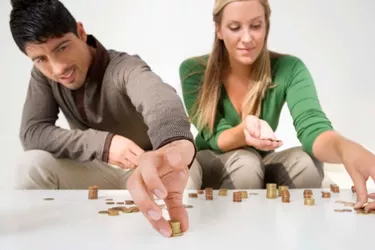
Do you get paid in tips? Or do you ever wonder where all that change you've been staring at for months is when you need to finish a purchase? It's in one of the console compartments in your car. It's in that dish near the table where you put your keys when you come in the house. It's in the bottom of your tennis or gym bag. It's in your purse, mixed in with 30 other items.
Keeping track of your change can help you avoid whipping out your credit card (and paying interest) because you don't have exact change at the fast-food drive through or gas mart. It can also add up to a nice surprise amount if you exchange it for paper bills at the end of the year.
Video of the Day
Video of the Day
You have three convenient methods for counting coins when you're ready to turn them in, or just find out how much extra cash you have.
Read More: How to Roll Coins
Use Paper Wrappers
The most old-school way to count your coins is to put them into paper wrappers. Your bank will probably provide them to you for free or you can buy them online if you'll be using many throughout the year. Once you know how many of each denomination goes in a wrapper, you can fill the wrappers, then do the math to find out how much you have.
For example, there are 50 pennies, 40 nickels, 50 dimes and 40 quarters to each paper roll. That means each roll of pennies is worth 50 cents, your nickel roll is worth $2, a roll of dimes is worth $5 and a roll of quarters is worth $10.
To make sure you're putting the correct amount of coins in each roll to get the correct change roll amounts, stack your coins in piles of 10 and drop them in the wrapper. Use your first roll as your guide to measure each successive roll. You can buy coin funnels that you insert into the paper wrappers for a quicker fill to help you determine your rolled coins amount.
Read More: How to Put Coins in Holders
Use a Plastic Sorter
If you're going to count coins on a regular basis, such as counting your tips after each shift, you can purchase a plastic sorter. Some look like a pan flute, with different size tubes in a row that let you fill them. Most coin tubes come in single sets, like medication bottles. You can do a quick online search for "coin tubes" and order one for overnight or regular delivery. Many come with tops so you can keep them handy and avoid spilling the coins.
You can empty each tube into a bowl, purse or pouch after you've filled them and counted the coins, or use the tubes to help slide the coins into a paper wrapper.
Read More: How a Coin Sorter Works
Use a Coin Machine
The easiest way to count coins is to have a machine do it for you. Many grocery stores have coin-counting machines that let you dump all of your coins (regardless of denomination) into the machine at once. A large wheels starts turning and the coins fall through holes that match up with each coin size.
If you need your coins back, this is not an option for you. The coin machine will either give you paper bills and your extra change, or give you a slip of paper to redeem for cash at the customer service counter. You'll also be charged a fee (usually a small percentage of your money) for the service.
Take It to the Bank
Depending on your bank's policies, they will sort and count your coins for you using a coin-sorting machine, free. They can deposit your money into your account for you after you fill out a counter slip. Your bank might charge a fee for this service.
Inspect Your Coins First
Make sure you sort your coins and make sure they are all American coins (if you'll be redeeming them in the U.S.) – it's not uncommon for Canadian coins to sneak into piles of pennies and dimes.